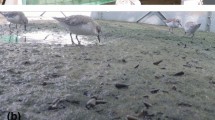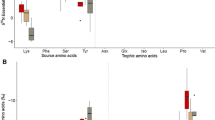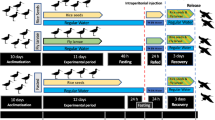Abstract
Using measurements of naturally occurring stable isotopes in feathers to determine avian origin and migratory patterns is well established. However, isotopically determining nutritional origins of lipids, a major migratory fuel, has not been attempted. This study explores isotopic links between diet and stored lipids in captive white-throated sparrows (Zonotrichia albicollis) by providing isotopically distinct mixtures of carbohydrates/oils and drinking water and assessing the δ13C and δ2H values of stored lipid, breath CO2 (δ13C) and breath water vapour (δ2H). Stored lipid δ13C and δ2H values correlated with the isotopic values found in dietary carbohydrates/oils and drinking water treatments, respectively, indicating a clear traceable transfer of environmental dietary isotopic signals into body lipids. Dietary oils and carbohydrates contributed 80–82% of carbon and 44–46% of hydrogen, respectively, to stored lipids. Drinking water contributed 18–28% of hydrogen to stored lipids. Isotopic relationships were quantifiable using linear calibration algorithms which provide the basis for the construction of tissue isoscapes for migratory passerines. Breath CO2 δ13C values and breath water vapour δ2H values for fed and fasted birds reflected dietary sources. Breath CO2 δ13C values were higher for fasted birds than for fed birds by an average of 4.5‰ while breath water vapour δ2H values were lower for fasted birds by an average of 48.9‰. These results indicate that lipids and metabolites from their subsequent breakdown for fuel isotopically reflect dietary sources but complicate interpretation of such data, especially for wild migrating birds. Applications and limitations of these findings to the creation of “liposcapes” are examined.



Similar content being viewed by others
References
Baloun D, Hobson KA, Guglielmo C (2020) Temporal patterns of foraging by silver-haired bats during migratory stopover revealed by isotopic analysis (13C) of breath CO2. Oecologia. https://doi.org/10.1007/s00442-020-04650-8
Bowen GJ (2010) Isoscapes: spatial pattern in isotopic biogeochemistry. Annu Rev Earth Pl Sc 38:161–187. https://doi.org/10.1146/annurev-earth-040809-152429
Bowen GJ, West JB (2019) Isoscapes for terrestrial migration research. In: Hobson KA, Wassenaar LI (eds) Tracking animal migration with stable isotopes, 2nd edn. Academic Press, London, pp 53–84
Bowen GJ, Wassenaar LI, Hobson KA (2005) Global application of stable hydrogen and oxygen isotopes to wildlife forensics. Oecologia 143:337–348. https://doi.org/10.1007/s00442-004-1813-y (PMID:15726429)
Bowen GJ, Ehleringer JR, Chesson LA, Thompson AH, Podlesak DW, Cerling TE (2009) Dietary and physiological controls on the hydrogen and oxygen isotope ratios of hair from mid-20th century indigenous populations. Am J Phys Anthropol 139:494–504. https://doi.org/10.1002/ajpa.21008
Caut S, Angulo E, Courchamp F (2009) Variation in discrimination factors (Δ15N and Δ13C): the effect of diet isotopic values and applications for diet reconstruction. J Appl Ecol 46:443–453. https://doi.org/10.1111/j.1365-2664.2009.01620.x
Cernusak LA, Barbour MM, Arndt SK, Cheesman AW, English NB, Field TS, Helliker BR, Holloway-Phillips MM, Holtum JAM, Kahmen A, McInerney FA, Munskgaard NC, Simonin KA, Song X, Stuart-Williams H, West JB, Farquhar GD (2015) Stable isotopes in leaf water of terrestrial plants. Plant Cell Envrion 39:1087–1102
Clerc J, Weller TJ, Schineller JB, Szewczak JM (2017) Minimally invasive collection of adipose tissue facilitates the study of eco-physiology in small-bodied mammals. Methods Ecol Evol 8:109–115. https://doi.org/10.1111/2041-210X.12646
Crabtree B, Newsholme EA (1975) Comparative aspects of fuel utilization and metabolism by muscle. In: Usherwood PNR (ed) Insect muscle. Academic Press, New York, pp 405–500
DeNiro MJ, Epstein S (1977) Mechanism of carbon isotope fractionation associated with lipid synthesis. Science 197:261–263. https://doi.org/10.1126/science.327543
Droste HJ, Zebe E (1974) Carbohydrases and carbohydrate digestion in the gut of Locusta migratoria. J Insect Physiol 20:1639–1657. https://doi.org/10.1016/0022-1910(74)90093-6
Egeler O, Seaman D, Williams TD (2003) Influence of diet on fatty-acid composition of depot fat in Western Sandpipers (Calidris mauri). Auk 120:337–345. https://doi.org/10.1093/auk/120.2.337
Ehleringer JR, Bowen GJ, Chesson LA, West AG, Podlesak DW, Cerling TE (2008) Hydrogen and oxygen isotope ratios in human hair are related to geography. P Natl Acad Sci USA 105:2788–2793. https://doi.org/10.1093/auk/120.2.337
Engel S, Lease HM, McDowell NG, Corbett AH, Wolf BO (2009) The use of tunable diode laser absorption spectroscopy for rapid measurements of the δ13C of animal breath for physiological and ecological studies. Rapid Commun Mass Sp 23:1281–1286. https://doi.org/10.1007/s00360-015-0950-4
Falls JB, Kopachena JG (2010) White-throated Sparrow (Zonotrichia albicollis), version 20 The Birds of North America. Cornell Lab of Ornithology, Ithaca. https://doi.org/10.2173/bna.128
Farquhar GD, O’Leary MH, Berry JA (1982) On the relationship between carbon isotope discrimination and the intercellular carbon dioxide concentration in leaves. Funct Plant Biol 9:121–137. https://doi.org/10.1071/PP9820121
Farquhar GD, Cernusak LA, Barnes B (2007) Heavy water fractionation during transpiration. Plant Physiol 143:11. https://doi.org/10.1104/pp.106.093278
Fry B (2006) Stable isotope ecology. Springer, New York
Guglielmo GC (2018) Obese super athletes: fat-fueled migration in birds and bats. J Exp Biol 221:165753. https://doi.org/10.1242/jeb.165753
Hatch KA, Pinshow B, Speakman JR (2002) Carbon isotope ratios in exhaled CO2 can be used to determine not just present, but also past diets in birds. J Comp Physiol B 172:263–268. https://doi.org/10.1007/s00360-002-0251-6
Hayes JM (2001) Fractionation of carbon and hydrogen isotopes in biosynthetic processes. Rev Mineral Geochem 43:225–277. https://doi.org/10.2138/gsrmg.43.1.225
Hobson KA (2006) Using stable isotopes to quantitatively track endogenous and exogenous nutrient allocations to eggs of birds that travel to breed. Ardea 94:359–369
Hobson KA, Wassenaar LI (1996) Linking breeding and wintering grounds of neotropical migrant songbirds using stable hydrogen isotopic analysis of feathers. Oecologia 109:142–148. https://doi.org/10.1007/s004420050068
Hobson KA, Wassanaar LI (2019) Tracking animal migration with stable isotopes, 2nd edn. Academic Press, London
Hobson KA, Atwell L, Wassenaar LI (1999a) Influence of drinking water and diet on the stable hydrogen isotope ratios of animal tissues. Proc Natl Acad Sci USA 96:8003–8006. https://doi.org/10.1073/pnas.96.14.8003
Hobson KA, Wassenaar LI, Taylor OR (1999b) Stable isotopes (δD and δ13C) are geographic indicators of natal origins of monarch butterflies in eastern North America. Oecologia 120:397–404. https://doi.org/10.1007/s004420050872
Hobson KA, Van Wilgenburg SL, Wassenaar LI, Powell RL, Still CJ, Craine JM (2012) A multi-isotope (δ13C, δ15N, δ2H) feather isoscape to assign Afrotropical migrant birds to origins. Ecosphere 3(5):44. https://doi.org/10.2478/ami-2012-0002
Hobson KA, Jaatinen K, Öst M (2015) Differential contributions of endogenous and exogenous nutrients to egg components in wild Baltic Common Eiders (Somateria mollissima): a test of alternative stable isotope approaches. Auk 132:624–633. https://doi.org/10.1642/AUK-14-294.1
Hobson KA, Doward K, Kardynal KJ, McNeil JN (2018) Inferring origins of migrating insects using isoscapes: a case study using the true armyworm, Mythimna unipuncta, in North America. Ecol Entomol 43:332–341. https://doi.org/10.1111/een.12505
Horita J, Wesolowski DJ (1994) Liquid-vapor fractionation of oxygen and hydrogen isotopes of water from the freezing to the critical temperature. Geochim eCosmochim Acta 58:3425–3437. https://doi.org/10.1016/0016-7037(94)90096-5
Hupp J, Ward D, Soto DX, Hobson KA (2018) Spring temperature, migration chronology, and nutrient allocation to eggs in three species of Arctic-nesting geese: implications for resilience to climate warming. Glob Change Biol 24:5056–5071. https://doi.org/10.1007/s00442-019-04533-7
Iverson SJ, Field C, Bowen WD, Blanchard W (2004) Quantitative fatty acid signature analysis: a new method of estimating predator diets. Ecol Monogr 74:211–235. https://doi.org/10.1890/02-4105
Karasov WH, Martinez del Rio C (2007) Physiological ecology: how animals process energy, nutrients, and toxins. Princeton University Press, Princeton. https://doi.org/10.1086/586958
Katz JJ, Crespi HL, Hasterlik RJ, Thomson JF, Finkel AJ (1957) Some observations on biological effects of deuterium, with special reference to effects on neoplastic processes. J Natl Cancer I 18:641–658. https://doi.org/10.1093/jnci/18.5.641
Kays R, Feranec RS (2011) Using stable carbon isotopes to distinguish wild from captive wolves. Northeast Nat 18:253–264. https://doi.org/10.1656/045.018.0301
Kelly JF (2000) Stable isotopes of carbon and nitrogen in the study of avian and mammalian trophic ecology. Can J Zool 78:1–27. https://doi.org/10.1139/z99-165
Klasing KC (1998) Nutritional strategies and adaptations. In: Comparative avian nutrition. CAB International, New York, pp 71–124
Lajtha K, Michener R (2007) Stable isotopes in ecology and environmental science, 2nd edn. Blackwell Publishing Ltd., Oxford. https://doi.org/10.1002/9780470691854
Lepoint G, Cox AS, Dauby P, Poulicek M, Gobert S (2006) Food sources of two detritivore amphipods associated with the seagrass Posidonia oceanica leaf litter. Mar Biol Res 2:355–365. https://doi.org/10.1080/17451000600962797
López-Calderón C, Hobson KA, Marzal A, Balbontín J, Reviriego M, Magallanes S, García-Longoria L, de Lope F, Møller AP (2017) Environmental conditions during winter predict age- and sex-specific differences in reproductive success of a trans-Saharan migratory bird. Sci Rep 7:18082. https://doi.org/10.1038/s41598-017-18497-2
Magozzi S, Vander Zanden HB, Wunder MB, Bowen GJ (2019) Mechanistic model predicts tissue–environment relationships and trophic shifts in animal hydrogen and oxygen isotope ratios. Oecologia 191:777–789. https://doi.org/10.1007/s00442-019-04532-8
Majoube M (1971) Fractionnement en oxygene 18 et en deuterium entre l’eau et sa vapeur. J Chim Phys 68:1423–1436. https://doi.org/10.1051/jcp/1971681423
McCue MD (2011) Tracking the oxidative and nonoxidative fates of isotopically labeled nutrients in animals. Bioscience 61:217–230. https://doi.org/10.1525/bio.2011.61.3.7
McCue MD, Pollock ED (2013) Measurements of substrate oxidation using 13CO2-breath testing reveals shifts in fuel mix during starvation. J Comp Physiol B 183:1039–1052. https://doi.org/10.1007/s00360-013-0774-z
McCue MD, Welch KC (2016) 13C-Breath testing in animals: theory, applications, and future directions. J Comp Physiol B 186:265–285. https://doi.org/10.1007/s00360-015-0950-4
McCue MD, Sivan O, McWilliams SR, Pinshow B (2010) Tracking the oxidative kinetics of carbohydrates, amino acids, and fatty acids in the house sparrow using exhaled 13CO2. J Exp Biol 213:782–789. https://doi.org/10.1242/jeb.039842
McCue MD, Passement CA, Rodriguez M (2015) The magnitude of the naturally occurring isotopic enrichment of 13 C in exhaled CO2 is directly proportional to exercise intensity in humans. Comp Biochem Physiol 179A:164–171. https://doi.org/10.1016/j.cbpa.2014.08.021
McCue MD, Javal M, Clusella-Trullas S, Le-Roux JJ, Jackson MC, Ellis AG, Richardson DM, Valentine AJ, Terblanche JS (2020) Using stable isotope analysis to answer fundamental questions in invasion ecology: progress and prospects. Methods Ecol Evol 11:196–214. https://doi.org/10.1111/2041-210X.13327
McWilliams RS, Guglielmo C, Pierce B, Klaassen M (2004) Flying, fasting, and feeding in birds during migration: a nutritional and physiological ecology perspective. J Avian Biol 35:377–393. https://doi.org/10.1111/j.0908-8857.2004.03378.x
Middelburg JJ (2014) Stable isotopes dissect aquatic food webs from the top to the bottom. Biogeosciences 11:2357–2371. https://doi.org/10.5194/bg-11-2357-2014
Mitchell GW, Guglielmo CG, Hobson KA (2015) Measurement of whole body CO2 production in birds using real-time laser-derived measurements of hydrogen (δ2H) and oxygen (δ18O) isotope concentrations in water vapor from breath. Physiol Biochem Zool 88:599–606. https://doi.org/10.1086/683013
Moermond TC, Denslow JS (1985) Neotropical avian frugivores: patterns of behavior, morphology, and nutrition, with consequences for fruit selection. Ornithol Monogr 36:865–897. https://doi.org/10.2307/40168322
Moore FR, Buler JJ, Woltmann S (2007) A multi-scale examination of stopover habitat use by birds. Ecology 88:1789–1802. https://doi.org/10.1890/06-1871.1
Mora G, Zanazzi A (2017) Hydrogen isotope ratios of moss cellulose and source water in wetlands of Lake Superior, United States reveal their potential for quantitative paleoclimatic reconstructions. Chem Geo 468:75–83. https://doi.org/10.1016/j.chemgeo.2017.08.017
Moran JA, Wassenaar LI, Finlay JC, Hutchison C, Isaac LA, Wethington SM (2012) An exploration of migratory connectivity of the Rufous Hummingbird (Selasphorus rufus), using feather deuterium. J Ornithol 154:423–430. https://doi.org/10.1007/s10336-012-0906-3
Nicolosi RJ (1997) Dietary fat saturation effects on low-density-lipoprotein concentrations and metabolism in various animal models. Am J Clin Nutr 65:1617–1627. https://doi.org/10.1093/ajcn/65.5.1617S
Odum EP, Connell CE (1956) Lipid levels in migrating birds. Science 123:892–894. https://doi.org/10.1126/science.123.3203.892-a
Pearce J (1980) Comparative aspects of lipid metabolism in avian species. Biochem Soc Trans 8:295–296. https://doi.org/10.1042/bst0080295
Peterson BJ, Fry B (1987) Stable isotopes in ecosystem studies. Annu Rev Ecol Syst 18:293–320. https://doi.org/10.1146/annurev.es.18.110187.001453
Pierce BJ, McWilliams SR (2004) Diet quality and food limitation affect the dynamics of body composition and digestive organs in a migratory songbird (Zonotrichia albicollis). Physiol Biochem Zool 77:471–483. https://doi.org/10.1086/383503
Pierce BJ, McWilliams SR (2005) Seasonal changes in composition of lipid stores in migratory birds: causes and consequences. Condor 107:269–279. https://doi.org/10.1650/7809
Piersma T, Jukema J (1990) Budgeting the flight of a long-distance migrant: changes in nutrient reserve levels of bartailed godwits at successive spring staging sites. Ardea 78:315–337. https://doi.org/10.5253/arde.v78.p315
Podlesak DW, McWilliams SR (2007) Metabolic routing of dietary nutrients in birds: effects of dietary lipid concentration on δ13C of depot fat and its ecological implications. Auk 124:916–925. https://doi.org/10.1642/0004-8038(2007)124[916:MRODNI]2.0.CO;2
Post DM (2002) Using stable isotopes to estimate trophic position: models, methods, and assumptions. Ecology 83:703–718. https://doi.org/10.1890/00129658(2002)083[0703:USITET]2.0.CO;2
Price ER, Krokfors A, Guglielmo CG (2008) Selective mobilization of fatty acids from adipose tissue in migratory birds. J Exp Biol 211:29–34. https://doi.org/10.1242/jeb.009340
Romano A, Mackie A, Farina F, Aponte M, Sarghini F, Masi P (2016) Characterization, in vitro digestibility and expected glycemic index of commercial starches as uncooked ingredients. J Food Sci Tech 53(12):4126–4134. https://doi.org/10.1007/s13197-016-2375-9
Schimmelmann A (1991) Determination of the concentration and stable isotopic composition of nonexchangeable hydrogen in organic matter. Anal Chem 63:2456–2459. https://doi.org/10.1021/ac00021a013
Sessions AL, Burgoyne TW, Schimmelmann A, Hayes JM (1999) Fractionation of hydrogen isotopes in lipid biosynthesis. Org Geochem 30:1193–1200. https://doi.org/10.1016/S0146-6380(99)00094-7
Shi L, Tu BP (2015) Acetyl-CoA and the regulation of metabolism: mechanisms and consequences. Curr Opin Cell Biol 33:125–131. https://doi.org/10.1016/j.ceb.2015.02.003
Smith BN, Epstein S (1970) Biogeochemistry of the stable isotopes of hydrogen and carbon in salt marsh biota. Plant Physiol 46:738–742. https://doi.org/10.1104/pp.46.5.738
Smith SB, McWilliams SR, Guglielmo CG (2007) Effect of diet composition on plasma metabolite profiles in a migratory songbird. Condor 109:48–58. https://doi.org/10.1093/condor/109.1.48
Soto DX, Wassenaar LI, Hobson KA (2013) Stable hydrogen and oxygen isotopes in aquatic food webs are tracers of diet and provenance. Funct Ecol 27:535–543. https://doi.org/10.1111/1365-2435.12054
Soto DX, Koehler G, Wassenaar LI, Hobson KA (2017) Re-evaluation of the hydrogen stable isotopic composition of keratin calibration standards for wildlife and forensic science applications. Rapid Commun Mass Sp 31(14):1193–1203. https://doi.org/10.1002/rcm.7893
Still CJ, Powell RL (2010) Continental-scale distributions of vegetation stable carbon isotope ratios. In: West JB, Bowen GJ, Dawson TE, Tu KP (eds) Isoscapes: understanding movements, pattern, and process on earth through isotope mapping. Springer, New York, pp 179–194. https://doi.org/10.2478/ami-2012-0002
Subramaniam S, Fahy E, Gupta S, Sud M, Byrnes RW, Cotter D, Dinasarapu AR, Maurya MR (2011) Bioinformatics and systems biology of the lipidome. Chem Rev 111:6452–6490. https://doi.org/10.1021/cr200295k
Taicher GZ, Tinsley FC, Reiderman A, Heiman ML (2003) Quantitative magnetic resonance (QMR) method for bone and whole-body-composition analysis. Anal Bioanal Chem 377:990–1002. https://doi.org/10.1007/s00216-003-2224-3
Terzer S, Wassenaar LI, Araguás-Araguás LJ, Aggarwal PK (2013) Global isoscapes for δ18O and δ2H in precipitation: improved prediction using regionalized climatic regression models. Hydrol Earth Syst Sci 17:4713–4728. https://doi.org/10.5194/hess-17-4713-2013
Vaillancourt E, Weber JM (2007) Lipid mobilization of long-distance migrant birds in vivo: the high lipolytic rate of ruff sandpipers is not stimulated during shivering. J Exp Biol 210:1161–1169. https://doi.org/10.1242/jeb.003012
Vallerand AL, Zamecnik J, Jones PJ, Jacobs IH (1999) Cold stress increases lipolysis, FFA Ra and TG/FFA cycling in humans. Aviat Sp Environ Md 70:42–50
Vander Zanden HB, Soto DX, Bowen GJ, Hobson KA (2016) Expanding the isotopic toolbox: applications of hydrogen and oxygen stable isotope ratios to food web studies. Front Ecol Evol 4:20. https://doi.org/10.3389/fevo.2016.00020
Viscarra JA, Ortiz RM (2013) Cellular mechanisms regulating fuel metabolism in mammals: role of adipose tissue and lipids during prolonged food deprivation. Metabolism 62:889–897. https://doi.org/10.1016/j.metabol.2012.12.014
Voigt CC, Baier L, Speakman JR, Siemers BM (2008a) Stable carbon isotopes in exhaled breath as tracers for dietary information in birds and mammals. J Exp Biol 211:2233–2238. https://doi.org/10.1242/jeb.018523
Voigt CC, Rex K, Michener RH, Speakman JR (2008b) Nutrient routing in omnivorous animals by stable carbon isotopes in tissue and exhaled breath. Oecologia 157:31–40. https://doi.org/10.1007/s00442-008-1057-3
Voigt CC, Sorgel K, Suba J, Keiss O, Petersons G (2012) The insectivorous bat Pipistrellus nathusii uses a mixed-fuel strategy to power autumn migration. Proc R Soc B 279:3772–3778. https://doi.org/10.1098/rspb.2012.0902
Wassenaar LI (2019) Introduction to conducting stable isotope measurements for animal migration studies. In: Hobson KA, Wassenaar LI (eds) Tracking animal migration with stable isotopes, 2nd edn. Academic Press, London, pp 25–51
Weber JM (1992) Pathways for oxidative fuel provision to working muscles: ecological consequences of maximal supply limitations. Experientia 48:557–564. https://doi.org/10.1007/BF01920239
Welch KC, Péronnet F, Hatch KA, Voigt CC, McCue MD (2016) Carbon stable-isotope tracking in breath for comparative studies of fuel use. Ann NY Acad Sci 1365:15–32. https://doi.org/10.1111/nyas.12737
West AG, Goldsmith GR, Brooks PD, Dawson TE (2010) Discrepancies between isotope ratio infrared spectroscopy and isotope ratio mass spectrometry for the stable isotope analysis of plant and soil waters. Rapid Commun Mass Sp 24:1948–1954. https://doi.org/10.1002/rcm.4597
Whiteman JP, Elliott-Smith EA, Besser AC, Newsome SD (2019) A guide to using compound-specific stable isotope analysis to study the fates of molecules in organisms and ecosystems. Diversity 11:8. https://doi.org/10.3390/d11010008
Wolf N, Bowen GJ, Martinez del Rio C (2011) The influence of drinking water on the δD and δ18O values of house sparrow plasma, blood and feathers. J Exp Biol 214:98–103. https://doi.org/10.1242/jeb.050211
Xie X, Zubarev RA (2014) Effects of low-level deuterium enrichment on bacterial growth. PLoS ONE 9:e102071. https://doi.org/10.1371/journal.pone.0102071
Zaefarian F, Abdollahi MR, Cowieson A, Ravindran V (2019) Avian liver: the forgotten organ. Animals 9(2):63. https://doi.org/10.3390/ani9020063
Acknowledgements
We thank Scott MacDougall-Shackleton for providing the white-throated sparrows and for advising on captive rearing. Blanca X. Mora-Alvarez assisted in the lab. Chris Guglielmo provided much advice and assistance with QMR and breath analyses. The LSIS-AFAR stable isotope facility at the University of Western Ontario and the Environment and Climate Change Canada stable isotope facility in Saskatoon, Saskatchewan provided stable isotope analyses. Blaire Wolf and an anonymous reviewer provided valuable comments on a previous draft of the manuscript.
Funding
This research was funded by a Natural Science and Engineering Research Council of Canada (NSERC) operating grant (#2017-04430) to KAH.
Author information
Authors and Affiliations
Contributions
KAH and LA originally formulated the idea, KAH and LA developed methodology, LA conducted fieldwork, KAH developed the mathematical models and graphical depictions and performed the stable isotope analyses, LA performed statistical analyses, LA wrote the manuscript and KAH was manuscript editor.
Corresponding author
Ethics declarations
Conflict of interest
We declare no competing interests.
Additional information
Communicated by Blair Wolf.
Supplementary Information
Below is the link to the electronic supplementary material.
Rights and permissions
About this article
Cite this article
Anparasan, L., Hobson, K.A. Tracing sources of carbon and hydrogen to stored lipids in migratory passerines using stable isotope (δ13C, δ2H) measurements. Oecologia 195, 37–49 (2021). https://doi.org/10.1007/s00442-020-04827-1
Received:
Accepted:
Published:
Issue Date:
DOI: https://doi.org/10.1007/s00442-020-04827-1




